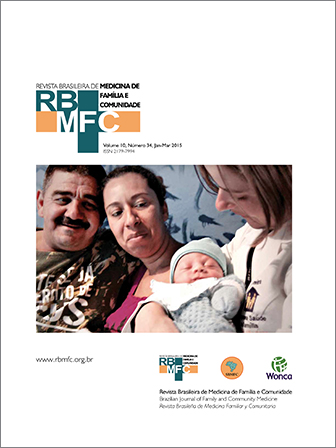The person at the center of care in the practice of the family doctor
DOI:
https://doi.org/10.5712/rbmfc10(34)870Keywords:
Family Practice, Patient-Centered Care, Physician-Patient RelationsAbstract
Objective: a person-centered practice is essential to the family and community doctor in the face of changes in society in the nineteenth and twentieth centuries. This article reports on a case study whose objective was to identify if the components that uniquely characterize the Person Centered Clinical Approach are present in the practice of the family doctor. Methods: data were collected through interviews with family doctors and with people seen by them. The interviews were recorded, transcribed and analyzed using the Discourse of the Collective Subject. Results: the study identified common or contradictory discourses of people and doctors on the application of the person-centered approach. Conclusion: family doctors still lack adequate knowledge about the meaning and application of the Person-Centered Clinical Approach.
Downloads
Metrics
References
Cassel EJ. The nature of suffering and the goals of medicine. N Engl J Med. 1982;306:639-645. http://dx.doi.org/10.1056/NEJM198203183061104 DOI: https://doi.org/10.1056/NEJM198203183061104
Stewart M. Patiente-centered medicine: transforming the clinical method. 2a ed. Abingdon, United Kingdon: Redcliffe Medical; 2003.
Little P. Observational study of effect of patient centredness and positive approach on outcomes of general practice consultations. BMJ. 2001;323(908-911). http://dx.doi.org/10.1136/bmj.323.7318.908 DOI: https://doi.org/10.1136/bmj.323.7318.908
Rakel RE. Essentials of family practice. 2a ed. Philadelphia: Saunders; 1998.
McWhinney IR. A textebook of family medicine. 2a ed. New York: Oxford University Press; 1997.
Lopes JMC. A pessoa como centro do cuidado: a abordagem centrada na pessoa no processo de produção do cuidado médico em Serviço de Atenção Primária à Saúde, 2005 [dissertação]. Rio Grande do Sul: Universidade Federal do Rio Grande do Sul; 2005. Portuguese. Disponível em: http://hdl.handle.net/10183/5873
Lefèvre F, Lefèvre AMC. Discurso do sujeito coletivo: um novo enfoque em pesquisa qualitativa (Desdobramentos). Caxias do Sul, RS: EDUCS; 2003.
Boff L. Saber cuidar, ética do humano: compaixão pela terra. 9a ed. Petrópolis: Vozes; 2003.
Starfield B. Atenção primária equilíbrio entre as necessidades de saúde, serviços e tecnologia. Brasília: UNESCO, Ministério da Saúde; 2004.
Murray M, Berwick DM. Advanced access: reducing waiting and delays in primary care. Rev. JAMA. 2003;289(8):1035-40. http://dx.doi.org/10.1001/jama.289.8.1035 DOI: https://doi.org/10.1001/jama.289.8.1035
Wollmann A, Ros C, Lowen IMV, et al. Novas possibilidades de organizar o acesso e a agenda na Atenção Primária à Saúde. Curitiba: Prefeitura Municipal de Curitiba. Disponível em: http://www.saude.curitiba.pr.gov.br/images/cartilha%20acesso%20avan%C3%A7ado%2005_06_14.pdf
Chin JJ. Doctor-patient relationship: from medical paternalism to enhanced autonomy. Singapore Med J. 2002;43(3):152-155.
Clarke G, Hall RT, Rosencrance G. Physician-patient relations: no more models. Am J Bioeth. 2004;4(2):W16-W19.
http://dx.doi.org/10.1162/152651604323097934 DOI: https://doi.org/10.1162/152651604323097934
Coulter A. After Bristol: putting patients at the centre. BMJ. 2002;324:16. http://dx.doi.org/10.1136/bmj.324.7338.648 DOI: https://doi.org/10.1136/bmj.324.7338.648
Helman CG. Cultura, saúde e doença. 4a ed. Porto Alegre: Artmed; 2003.
Lown B. A arte perdida de curar. São Paulo: Fundação Petrópolis; 1997.
McWhinney IR. Beyond diagnosis: an approach to the integration of behavioural science and clinical medicine. NEJM. 1972;287:384-387. http://dx.doi.org/10.1056/NEJM197208242870805 DOI: https://doi.org/10.1056/NEJM197208242870805
Downloads
Published
How to Cite
Issue
Section
License
By submitting a manuscript to the RBMFC, authors retain ownership of the copyright in the article, and authorize RBMFC to publish that manuscript under the Creative Commons Attribution 4.0 license and identify itself as the vehicle of its original publication.















